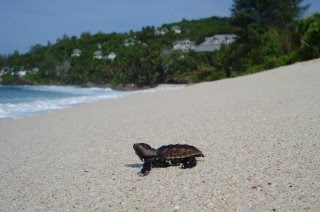Allison, a 5 year Green turtle, joins 20 year-old Loggerhead turtle, Yu-chan, in making history with regards to turtle rehabilitation.
Allison has spent most her life swimming in circles. Not surprising considering that she only has one flipper. At only 5 years old, she has finally been given a new lease on life after being fitted with a black neoprene “ninja” suit. The suit which looks like a wetsuit, covers about three-quarters of her body and has a carbon-fibre dorsal fin attached to her back, allowing Allison to glide gracefully across her 12-foot pool along with the other turtles at Sea Turtle Inc, a Texas not-for-profit group that rehabilitates injured sea turtles.
“That’s a sea turtle doing what a sea turtle does,” said Dave Cromwell, a worker at Sea Turtle Inc. who joined the cheering crowd gathered around the 3,000-gallon pool. Allison moved along tranquilly, cutting lazy arcs, diving to munch lettuce and nipping at other turtles. The fin was acting like a rudder and giving her stability, and she could change direction by varying the strokes of her front right flipper. The first time Allison dove down to feed at the improvised salad bar of waving Romaine. Some people watching wept, Cromwell said.
Rescuers at Sea Turtle Inc. believe that a shark probably chomped her three flippers. According to curator Jeff George, 2-flipper turtles can be adopted by zoos while 3-flipper turtles can be safely returned to the wild. With only one flipper, a turtle spins and struggles to break the surface to breathe and is therefore, usually euthanized.
When Allison arrived at Sea Turtle Inc. in 2005, she was a hand-size, bloodied turtle with little chance of survival. Allison, however, recovered from her injuries and wormed herself into the hearts of her rescuers enough that, in 2007, a team of scientists spent months trying to develop a prosthetic flipper to counter the thrust of her remaining paddle.
They made casts of hind flippers and high-tech prosthetics, but there was not enough of a stump remaining to attach it and it would either wobble loosely or cut off circulation if clamped down. Tom Wilson, a 21-year-old intern at Sea Turtle Inc. who stayed on to fine-tune Allison’s new gear, watched the failed attempts with the prosthetic and began thinking of a simpler solution. He thought of paddling a canoe and how its long keel allowed it to cut a fairly straight path through the water even if paddled from one side.
After fashioning a harness for Allison, the team experimented with various fin shapes and length and it soon became clear that this would work. Allison has gradually worked up from a few minutes swimming in the suit to two hours. Eventually she should be able to spend six hours a day gliding through the large pool, as she is gradually builds strength in her underutilized flipper. Her quality of life has improved dramatically and Allison shows her pleasure/displeasure by trying to swim away from the staff of Sea Turtle Inc. when its time to take the suit off.
 As Allison is expected to live over 150 years and could reach a weight of 500 to 600 pounds, its is important to refit her with new suits on a regular basis. Plans are underway for a figure-8 shaped pool with a shallow end where they will be able to get her in and out of the suit without carrying her from small pool to big pool as they do now.
As Allison is expected to live over 150 years and could reach a weight of 500 to 600 pounds, its is important to refit her with new suits on a regular basis. Plans are underway for a figure-8 shaped pool with a shallow end where they will be able to get her in and out of the suit without carrying her from small pool to big pool as they do now.Text and photos courtesy Sea Turtle Inc.










